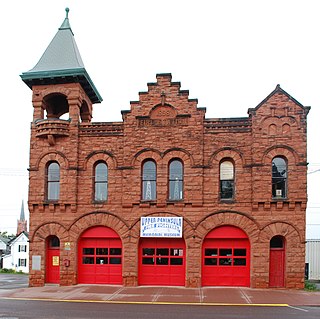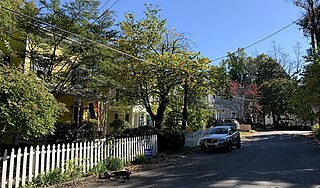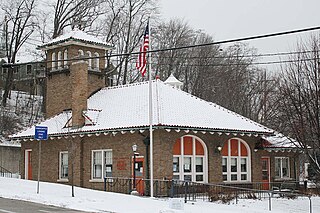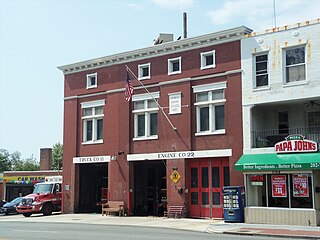
Georgetown is a historic neighborhood, and commercial and entertainment district located in Northwest Washington, D.C., situated along the Potomac River. Founded in 1751 in the Province of Maryland, the port of Georgetown predated the establishment of the federal district and the City of Washington by 40 years. Georgetown remained a separate municipality until 1871 when the United States Congress created a new consolidated government for the whole District of Columbia. A separate act, passed in 1895, specifically repealed Georgetown's remaining local ordinances and renamed Georgetown's streets to conform with those in the City of Washington.

Streetcars in Washington, D.C. transported people across the city and region from 1862 until 1962.

Christ Church, founded in 1817, is a historic Episcopal church located at 31st and O Streets, Northwest, Washington, D.C., in the Georgetown neighborhood. Its first rector was Reuel Keith (1792–1842), who with William Holland Wilmer rector of St. Paul's Church in 1818 founded an Education Society to train Episcopal priests. Rev. Keith left this parish in 1820 to accept a position at Bruton Parish Church and teach at the College of William and Mary in Williamsburg, Virginia, although he later returned to the new national capital and taught at the Virginia Theological Seminary when it was founded in 1823.

Engine House No. 8 was a historic fire station located at Baltimore, Maryland, United States. It was a two-story masonry building with a cast-iron street front, erected in 1871 in the Italianate style. The front featured a simple cornice with a central iron element bearing the legend "No. 8". Engine Company No. 8 operated from this building until 1912. In 1928 it became the motorcycle shop of Louis M. Helm and the upper story functioned as a clubhouse for a series of boys’ clubs into the 1940s.

The Oak Hill Cemetery Chapel, also known as the Renwick Chapel or James Renwick Chapel, is a historic building in the Georgetown neighborhood of Washington, D.C., United States. Designed by James Renwick, Jr. in 1850, Oak Hill Cemetery Chapel is the architect's only known example of Gothic Revival church architecture in Washington, D.C. It is located on the highest ridge in Oak Hill Cemetery, near the intersection of 29th and R Streets NW. The chapel is one of two structures in Oak Hill Cemetery listed on the National Register of Historic Places, the other being the Van Ness Mausoleum. The chapel, mausoleum, and cemetery are contributing properties to the Georgetown Historic District, a National Historic Landmark.

The Calumet Fire Station is a firehouse located on 6th Street in Calumet, Michigan. It is also known as the Red Jacket Fire Station. The building was designated a Michigan State Historic Site in 1971 and listed on the National Register of Historic Places in 1974, and is part of the Calumet Historic District and the Keweenaw National Historical Park. The building now houses the Upper Peninsula Fire Fighters Memorial Museum.

Engine House No. 7 is one of the original Fire Station Houses established by the District of Columbia Fire Department in the late 19th century. Built in 1884, Engine House No. 7 was home to Engine Co. No. 7 before the segregation of the Department in 1940 when it then housed the historic first all-black fire squad, Engine Co. No. 4. After Engine Co. No. 4 moved to a new location in 1976, Engine House No. 7 was sold to private owners and turned into a major local art studio.

The West End Hose Company Number 3 is a historic two-story brick firehouse located at 15 North Doughty Avenue in the borough of Somerville in Somerset County, New Jersey, United States. The building was added to the National Register of Historic Places on July 17, 2002 for its significance in architecture and social history. The building is currently the Somerville Fire Department Museum operated by the Somerville Exempt Firemen's Association.

The Embassy of Japan in Washington, D.C. is the diplomatic mission of Japan to the United States. It is located at 2520 Massachusetts Avenue NW, Washington, D.C., in the Embassy Row neighborhood. In addition to serving as Japan's diplomatic mission in the United States, the embassy provides Japanese consular services to residents of the District of Columbia, Virginia, and Maryland.

The Grant Road Historic District is located in the Tenleytown neighborhood of Washington, D.C. The two-block historic district is what remains of a former settlement in rural Washington County in the District of Columbia. It includes 13 contributing buildings and the road itself, a narrow remnant of a country road that was used by soldiers in the Civil War. Following the war, the road was named after Civil War general and President Ulysses S. Grant. Grant Road developed into a residential street lined with mostly small, two-story homes for working-class people.

The Port Washington Fire Engine House is located in Port Washington, Wisconsin. It was added to the National Register of Historic Places in 2009.

Engine Company 22, also known as the Brightwood Firehouse, was a fire station at #5760 Georgia Ave NW and it is also a historic structure located in the Brightwood Park neighborhood in Washington, D.C. It was listed on both the District of Columbia Inventory of Historic Sites and on the National Register of Historic Places in 2011. The two-story brick building was designed by Leon E. Dessez and built in stages. It was initially completed in 1897 and then enlarged between 1907 and 1911. The current address of DCFD Engine Company 22 and Truck Company 11 is #6825 Georgia Ave NW.

Engine Company 21, also known as the Lanier Heights Firehouse, is a fire station or firehouse and a historic structure located in the Lanier Heights neighborhood in Washington, D.C. It was listed on the District of Columbia Inventory of Historic Sites in 2005 and on the National Register of Historic Places in 2007. The building is attributed to local architect Appleton P. Clark, Jr., and built in 1908 in the Spanish Colonial Revival style. The station was built to serve the growing suburban areas of Washington north of Florida Avenue, NW. Because of its proximity to numerous multistory apartment buildings it housed the longest hook-and-ladder truck in the city.

The Evansville Standpipe is a historic water tower located in Evansville, Wisconsin. The 80-ft tall steel tower was built in 1901 by the Chicago Bridge & Iron Company, as part of the development of the local water supply system, spurred on by a devastating fire in 1896 that destroyed a large section of downtown Evansville. It was added to the National Register of Historic Places in 2008.

Truck Company F, at 1336-1338 Park Rd. NW in Washington, D.C., was built in 1900. It was listed on the National Register of Historic Places in 2007. The listing included two contributing buildings.

Engine Company 29, at 4811 MacArthur Blvd. NW in Washington, D.C., is a fire station built in 1925. It was listed on the National Register of Historic Places in 2007.

Albert L. Harris was an American architect who worked primarily in Washington, D.C. He was born in Wales and emigrated to the United States as a young child. He worked for architectural firms in Chicago and Baltimore and then Washington, where he also obtained an architectural degree from George Washington University. He was a part-time professor there while also working for the US Navy and then the city of Washington where he served as the city's Municipal Architect from 1921 until his death in 1933. A number of his works are listed on the National Register of Historic Places (NRHP).

The Chief Lippert Fire Station, also known as Chemical Engine House No. 1, is a historic fire station built in 1876, two miles north of Milwaukee's central business district. It was listed on the National Register of Historic Places in 1988.

The Brooklyn Fire Department (BFD) was a professional fire department that provided fire protection and rescue services to the city of Brooklyn, New York, within modern-day New York City, from 1869 to 1898. The Brooklyn Fire Department, a paid firefighting force, replaced a 3,000-person volunteer fire department that was poorly equipped to serve Brooklyn's growing population.






















